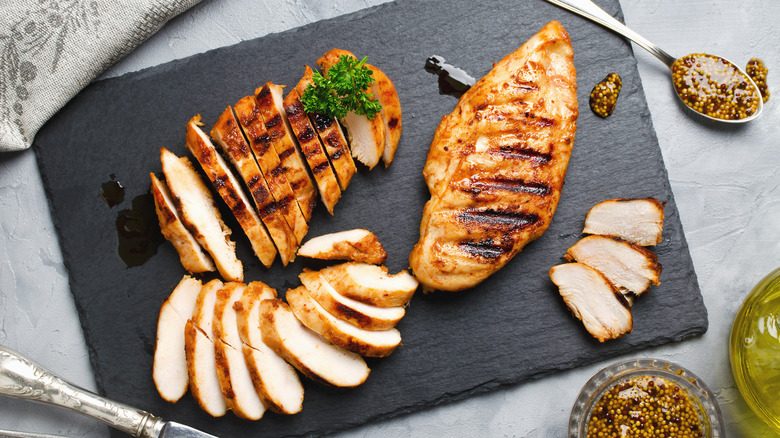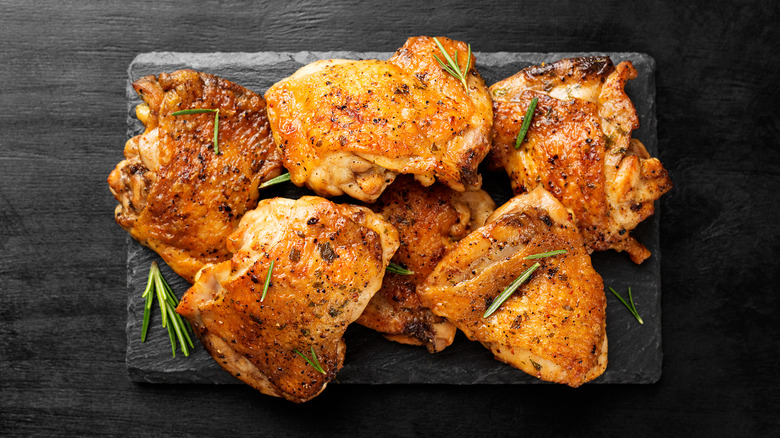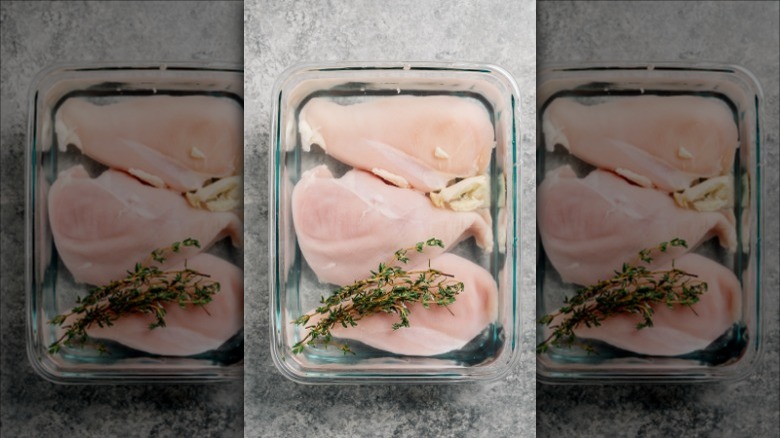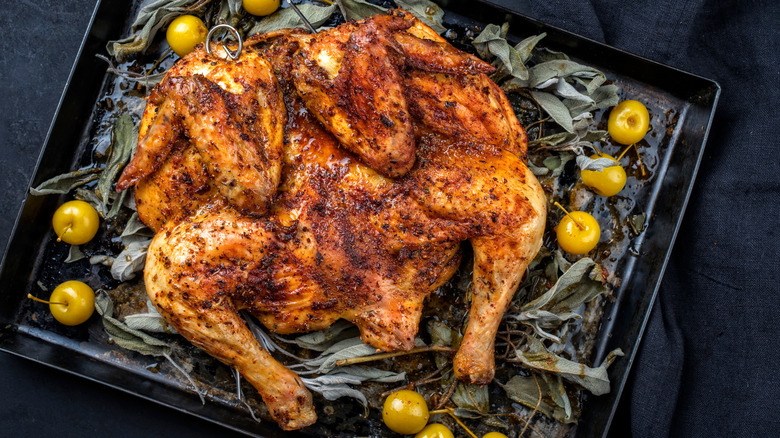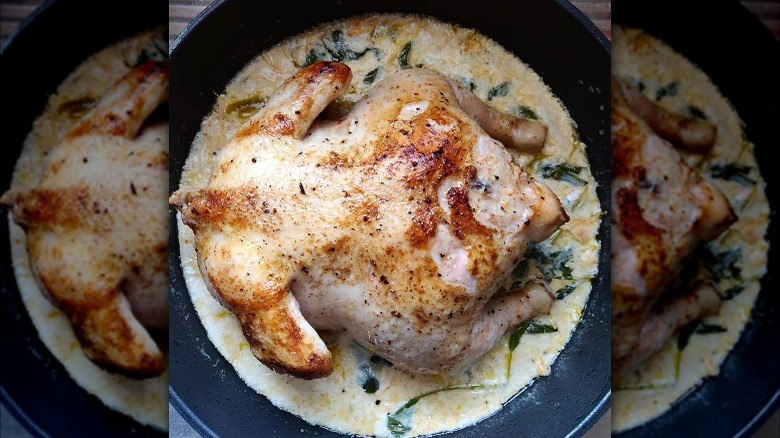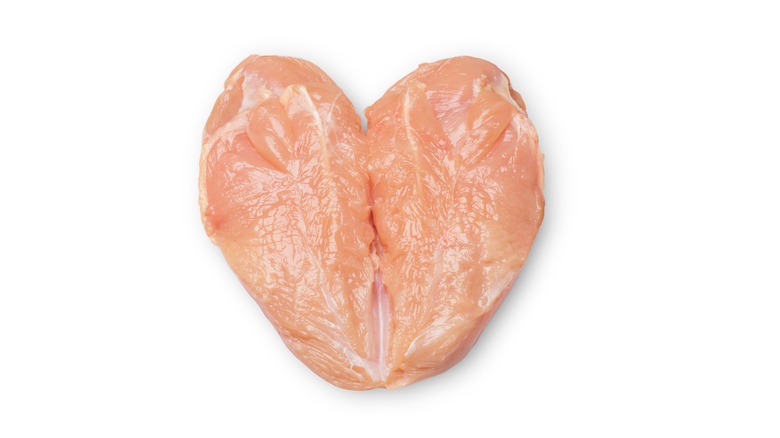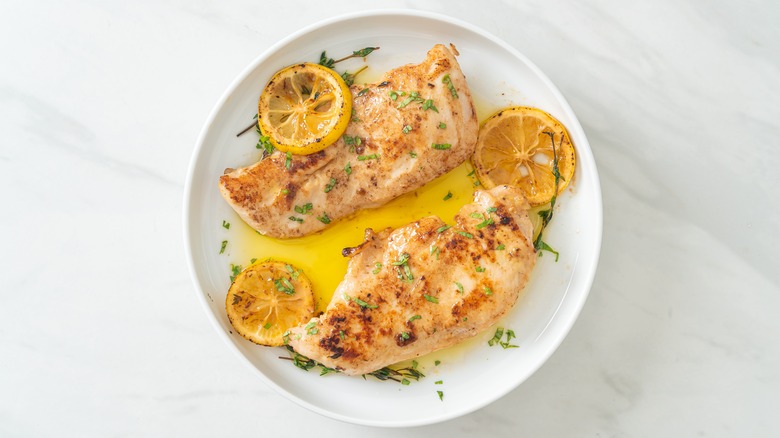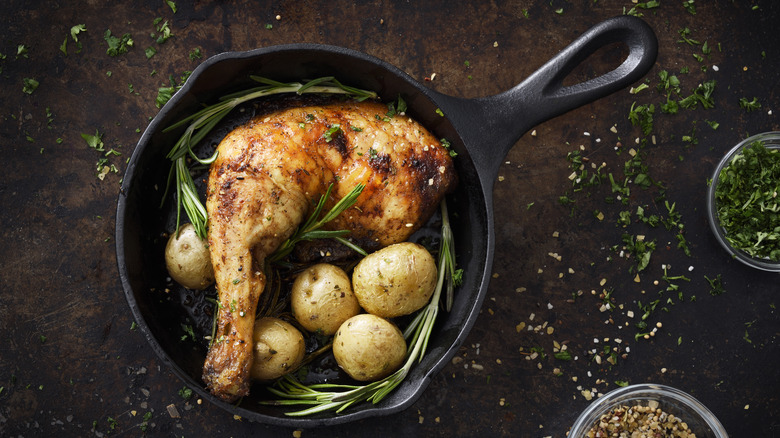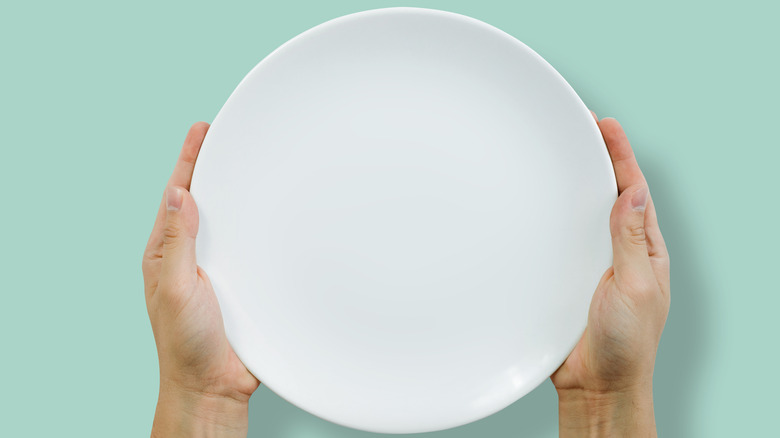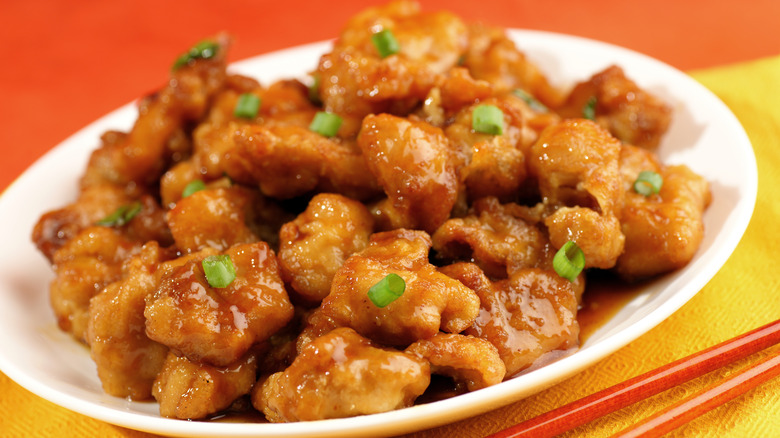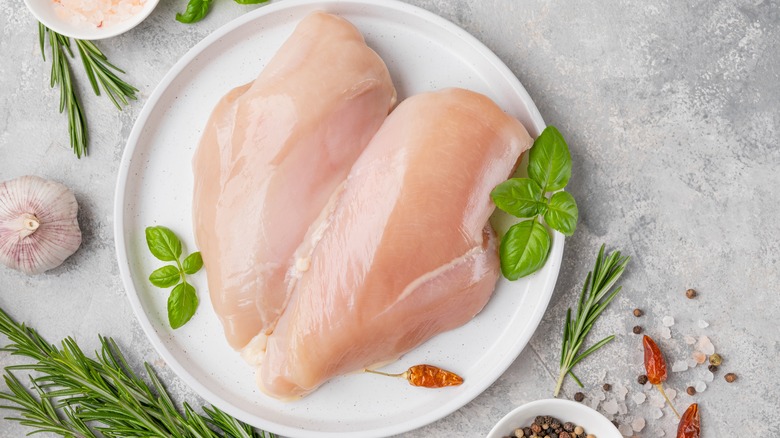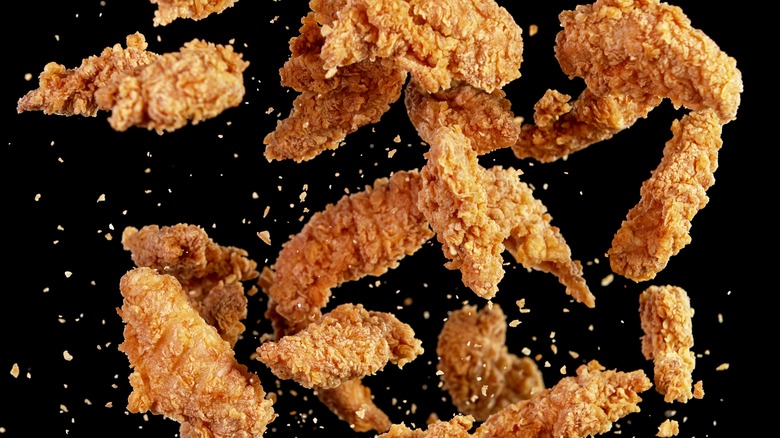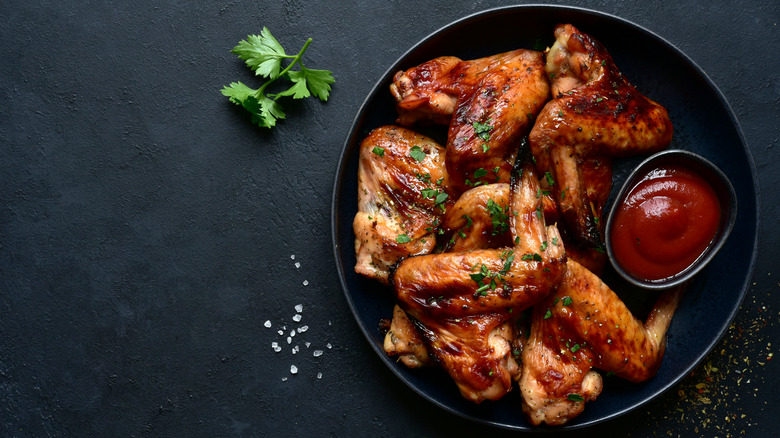Chicken Hacks That Are Total Game Changers
Chicken is the protein of choice for many home cooks. It's versatile, leaner than most meats, and light in flavor, making it an ingredient that can fit into just about any non-vegetarian meal plan. Whether you're looking for a quick weeknight dish or a main course for a special occasion, this white meat can suit your needs. And from chicken tikka masala to chicken cacciatore, it can take you on a journey through world cuisines at the same time.
But with all the many ways to make chicken, there are plenty of pitfalls. As a leaner meat, it can easily become tough and sinewy if cooked for too long. This is made more confounding by the fact that, like other types of poultry, it poses a higher health risk than other types of meat and therefore needs to be cooked to a higher temperature. Eating a rare steak is a delicacy, but a rare chicken breast is a cringe-inducing health hazard. These temperature requirements make it harder to avoid dry, overcooked meat, no matter how experienced you are in the kitchen or how good your recipe is.
For these reasons, you need as many hacks for cooking chicken as you can get, and luckily, we've got you covered. Before you start making your way through the best chicken recipes, read through these game-changing hacks and say goodbye to tough, flavorless chicken once and for all.
Pour boiling water over chicken thighs
Chicken thighs are full of flavor, but there's nothing appetizing about globs of fatty skin that you have to chew through to get to the meat. You want that skin to be thin and crispy, but it can be hard to achieve without overcooking the rest of the thigh. This seemingly hopeless catch-22 can be easily avoided, however, with the simplest of ingredients: water.
Before cooking the thighs, place them on a rack above a baking sheet and slowly pour boiling water over them. When you see the skin contracting, you know the technique is working. Then blot them dry, cook the thighs however you prefer, and marvel at the crispiness.
Pouring boiling water over chicken thighs makes the skin crispy because it pre-renders the fat. Rendering is the process by which raw fat melts and separates from its water content, turning into the juicy flavor explosion that makes fatty meat so succulent. But the process takes time and heat, meaning that when you cook chicken thighs without pouring boiling water over them first, much of the cooking time is spent rendering the fat. This can result in overcooked meat or undercooked, rubbery skin. Pre-rendering fast-tracks this process, allowing the skin to become crispy as the rest of the meat cooks to perfection. For best results, coat the raw chicken in salt the night before, drawing out as much moisture from the skin as possible before you cover them in boiling water.
Soak it in brine to retain moisture
Salt is often associated with removing moisture rather than maximizing it, but it turns out that soaking chicken in salt water is the key to attaining juiciness. When meat is cooked, its muscle fibers tighten, squeezing out the moisture. Salt water helps dissolve the muscle, preventing it from constricting as tightly while also injecting it with more moisture. It makes an especially noticeable difference in lean cuts of meat, such as chicken breasts, because fat provides juiciness, and without it, every drop of moisture is precious.
Aim for a ratio of 5% to 8% salt by weight compared to water, and dissolve it before adding the chicken. If you speed up the process by heating the water, it needs to be chilled before you add the meat. Poultry is a bacteria magnet if it's kept in the temperature range that the U.S. Department of Agriculture calls the "danger zone" (40 to 140 degrees Fahrenheit). You can either let the salt dissolve at room temperature before putting the chicken in and transferring it to the refrigerator, or chill the hot liquid before adding the chicken.
For chicken breasts, you need to set aside only 30 minutes for brining, but you can let them sit overnight if you have time. If you're brining a whole chicken, you need to plan ahead. A minimum of 12 hours should be your goal, but you can leave it for up to two days.
Spatchcock to solve all your roast chicken problems
Roast chicken can be finicky. If you cook it for too long, it's dry and leathery. If you don't cook it long enough, the inside will be an undercooked health risk. This is complicated by the fact that different parts of the chicken require different durations of cooking. Breasts cook faster than legs, for example, making it almost impossible to get a uniformly cooked bird. The size of the chicken also comes into play. If you stick to a strict cooking time of an hour and a half, you're likely to end up with an over- or undercooked dinner, even if it worked perfectly for you the last time.
Even thermometers can let you down. Chicken breasts are fully cooked when they reach a temperature of 150 degrees Fahrenheit, but legs need to reach at least 170 degrees. Most recipes split the difference by recommending an internal temperature of 165 degrees, but it's an imperfect science that yields unsatisfactory results.
Thankfully, there is a solution. Spatchcocking is a technique that involves flattening the bird by removing the backbone and breaking the breastbone with the palm of your hand before cooking it. This ensures that the legs and thighs cook more rapidly and require only as much time in the oven as the breast. It even cuts down on the overall roasting time. With a little muscle, you'll have an evenly cooked bird every time.
Add milk
If you've never cooked your chicken in milk, it's time to start. Yes, the same liquid you put in your coffee and pour over your Frosted Flakes is just as delicious when paired with poultry. If you don't want to take our word for it, look no further than Jamie Oliver, whose chicken in milk recipe first appeared in his third cookbook, "Happy Days with the Naked Chef," back in 2001.
Oliver's recipe involves lightly frying a whole chicken in a saucepan before adding lemon, sage, garlic, a stick of cinnamon, and lots of milk. Cinnamon and milk sound more like the basis of an autumnal Starbucks order than a roast chicken, but this recipe will change the way you think about this flavor combination.
The addition of lemon juice causes the milk to curdle, which is usually a nightmare for cooks, but it is the crux of the recipe in this case. The delicate curds create a cheese-like sauce that is nothing short of revelatory, and the remaining liquid causes the chicken to become so tender that it falls off the bone and melts in your mouth. Try this recipe, and you'll be wondering why it isn't the gold standard for every home cook.
Use a butterfly cut for chicken breasts
Chicken breasts are not conducive to even cooking. One side is thick while the other tapers into a vanishingly thin edge. Whether you're frying, roasting, or poaching this cut of meat, you'll have to settle for toughness on one half to avoid undercooking the thickest part. Most of us have been putting up with tough chicken breasts for so long that we just accept it as an inevitability, but there is a way to fix the problem.
Butterflying is the technique of slicing the chicken breast into a butterfly shape so that it has an even thickness. Instead of cutting it all the way through and creating separate halves, butterflying involves slicing the breast just far enough to open it like a book or a hamburger bun. The method ensures that the breast cooks at the same rate, and you don't end up with under- or overcooked chicken, but it also comes in handy for recipes like chicken Kyiv where you want to stuff the meat with delicious fillings.
Always add some kind of acid
Acid is the secret ingredient that will elevate both the texture and flavor of your chicken to new heights. There's a reason many chicken recipes include lemon or vinegar: Acid cuts through the fat to balance the flavors and breaks down the surface proteins of the chicken, which gives it a more tender finish. Many marinades contain salt and some form of sugar, and acid offers a refreshing third element to keep those elements in check and brighten the flavor of the dish.
Lemon juice and vinegar are frequently paired with chicken, but don't overlook the benefits of other types of acid, including yogurt. Where the citric acid in lemon juice breaks down the surface proteins quickly, the lactic acid in yogurt works more slowly. Leaving chicken to absorb a lemon-based marinade for more than an hour can create a mushy exterior, but the meat can be left in a yogurt-based marinade overnight, giving it more time to absorb the liquid and become even juicier. Regardless of the cut of chicken you're using, acid should always be on the ingredients list if you want a tender and flavorful result.
Use the cheap cuts for more flavor
"You get what you pay for" is a maxim that applies to many areas of cooking, from knives to fish, but in the case of chicken, it's inaccurate. Some of the cheapest cuts are the juiciest and most flavorful, and you shouldn't shy away from making them your go-to choice for even the fanciest of meals. You might automatically reach for the boneless, skinless items at the grocery store that also happen to be more expensive, but in doing so, you're missing out on a wealth of flavor. The bones contain fat that, when heated, melts into the meat and preserves juiciness while infusing it with flavor. The skin also helps retain moisture by releasing fat into the meat from the outside.
Boneless, skinless chicken breasts are the most expensive cut of the bird but often become tough when cooked due to their lack of fat. Drumsticks, thighs, and wings, in contrast, are full of juiciness when cooked on the bone, making them perfect for recipes meant to showcase the chicken flavor. They're not just for grilling and frying, either. You can use bone-in, skin-on chicken thighs for stir-fries, soups, and pasta dishes. All you have to do is set aside a little extra time to remove the meat from the bones. You will not only save money in the long run, but you'll also have the most flavorful chicken possible.
Wait a few minutes before tucking in
The last thing you want to do when your chicken has finally reached the right temperature and your kitchen is full of the mouth-watering aroma is to set a timer and watch it sit for 15 minutes. But patience pays off. When meat is heated, its muscle fibers contract, squeezing out the moisture like a sponge. Once it's taken off the heat and allowed to cool, those fibers relax and re-absorb the moisture. If you cut into your chicken while it's still piping hot, all those juices will pour out onto the dish, leaving the meat dry. But if you wait for the temperature to lower, those juices will be trapped inside the muscle fibers again, making the meat moist and juicy.
Timings are crucial. One or two minutes of resting is not sufficient. You need to let your meat sit for about half the time it took to cook. That's not a huge trade-off if you poached a small chicken breast for 10 minutes and only need to rest it for five, but it can be a test of patience with a larger cut. Luckily, 15 minutes is the longest you'll have to wait, even for a whole chicken. It may require extra willpower, but when you finally take that first bite of succulent, tender chicken, you'll be glad you made yourself do it.
Velvet your chicken breasts
Many chicken stir-fry recipes call for breast meat, but it's such a lean cut that it's almost impossible to avoid chewiness unless you undercook it. If you've ever run into this problem, you might have found yourself marveling at the delicate, juicy morsels of chicken at Chinese restaurants. It's so tender that it almost feels like velvet. Luckily, the technique that many Chinese restaurants use for their chicken is easily replicated at home.
Velveting chicken involves coating the meat in cornstarch or baking soda before cooking it. The process is similar to a standard marinade, but instead of simply adding flavor, it tenderizes the meat and smooths its texture. The process can be as simple as tossing slices of raw chicken with baking soda and letting them sit in the fridge for 20 minutes, or you can add a few extra steps for more flavor. Some recipes call for mixing the cornstarch or baking soda with oil, water, and seasonings, while others suggest adding egg white and soy sauce. Regardless of whether you choose to incorporate other ingredients, the ultra-fine texture of cornstarch and baking soda will give the chicken the silky texture you've been craving. Choose baking soda if you want to tenderize the meat, and opt for cornstarch if you're just looking for that velvety texture.
Bring the meat to room temperature before cooking
We all know that poultry can be a major health hazard at certain temperatures, but one of the keys to a perfectly cooked piece of meat is to start cooking it from room temperature. If you put it directly into a sizzling pan after it's been cooling in the refrigerator, you're going to end up with an overcooked outside and an undercooked middle. Tempering chicken requires more precision than other types of meat. Beef can be left at room temperature for hours without posing a serious health risk, but chicken shouldn't be left out for more than 15 minutes. As long as you stick to the right time frame, however, you don't need to worry about it becoming hazardous.
Cooking chicken from room temperature is particularly useful with chicken breasts, which are notoriously tricky to cook evenly due to the variations in thickness. For Gordon Ramsay, tempering is the secret to getting this fussy cut of meat right every time, along with opting for skin-on breasts. The combination ensures you'll have an evenly cooked chicken breast with added flavor and juiciness from the skin.
Add vodka to fried chicken
Of all the ways to prepare chicken, deep frying might be the most delicious. The crunchy batter and juicy meat are a match made in heaven, but it can be difficult to achieve. The oil can become too hot and burn the batter, or not hot enough and seep into the meat, making it greasy. On top of this, the batter can become a soggy, chewy mess if it sits too long or is stirred too frequently. To produce that perfect crunch, look no further than your liquor cabinet.
Vodka is the unlikely key to the crispiest crust. Simply add two tablespoons per cup of batter and discover the lightest, crunchiest fried chicken you've ever had outside of KFC. Vodka works in this context because, in contrast to water, it's highly volatile, evaporating much more quickly and leaving a frenzy of bubbles in its wake. The result is an airy, crunchy batter with none of the sogginess you might have encountered with previous attempts.
Another reason vodka is a magical ingredient is that it inhibits gluten production. The process that makes water and gluten the perfect match for bread is the same reason it can destroy fried chicken. When gluten and water interact, they form proteins that bond and toughen the texture of the dough. This can make fried chicken batter chewy rather than crunchy. Vodka, on the other hand, inhibits the formation of these protein bonds, leaving you with a feather-light layer of crunchiness.
Use bone-in chicken and moderate heat for grilling
The journey to mouth-watering grilled chicken begins not in the kitchen but at the grocery store. No marinade or state-of-the-art grill can compensate for the flavor differential between cuts. Forgo the familiar boneless, skinless chicken breast and boneless thighs in favor of cheaper, bone-in cuts. Grills are harder to work with than ovens because the direct, high heat can easily char the outside to a crisp while leaving the inside raw. Chicken breasts, with their thick, uneven shape, are a nightmare to cook all the way through, and their lack of fat makes them less flavorful than other cuts.
Bone-in thighs and wings are thinner, more uniform in thickness, and bursting with flavor. Not only are the bones a succulent source of tasty fat, but they also help to conduct heat and ensure an even distribution. It takes longer to cook bone-in chicken, but the final product is full of flavor and so tender it will fall off the bone before it can get to your mouth. Turn your grill down to moderate heat, crack open your favorite drink, and let the minutes roll by as you imagine the delight on people's faces when they take a bite of those perfectly grilled chicken thighs. Trust us: It's worth the wait.
